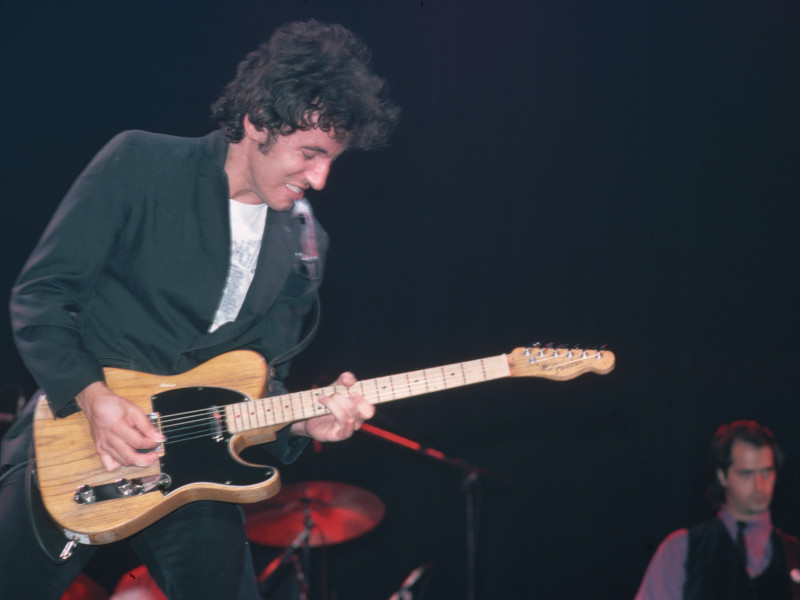Il y a 45 ans aujourd’hui : Bruce Springsteen sort « Darkness On The Edge Of Town » (L’obscurité au bord de la ville)
Il y a 45 ans aujourd’hui (le 2 juin 1978), Bruce Springsteen sortait enfin Darkness On The Edge Of Town, la suite tant attendue de Born To Run (1975). L’album a atteint la cinquième place du classement Billboard Pop Albums et est resté dans le Top 10 pendant huit semaines.
L’enregistrement du quatrième album de Springsteen a été bloqué pendant un an alors que Springsteen était en procès avec son ancien manager et producteur Mike Appel. Le procès d’Appel a empêché Springsteen d’enregistrer avec son futur manager et producteur Jon Landau.
Le tracklisting de Darkness On The Edge Of Town est le suivant : « Badlands », « Adam Raised A Cain », « Something In The Night », « Candy’s Room », « Racing In The Street », « The Promised Land », « Factory », « Streets Of Fire », « Prove It All Night » et « Darkness On The Edge Of Town ».
Les deux singles de l’album, bien qu’ils soient devenus des incontournables de la FM et des concerts, ont eu moins de succès au Billboard Hot 100 : « Prove It All Night » a atteint le 33e rang, et « Badlands » s’est arrêté au 42e rang.
Les sessions de Darkness ont généré des douzaines de prises, ainsi que des chansons qui sont devenues des succès pour d’autres artistes, notamment « Fire » pour les Pointer Sisters, « Because The Night » pour Patti Smith, et « Rendezvous » pour Greg Kihn et, plus tard, Gary « U.S. » Bonds.
Le 16 novembre 2010, Bruce Springsteen a sorti le coffret The Promise : The ‘Darkness On The Edge Of Town’ Story. Ce coffret contient la première version remastérisée de l’album Darkness, ainsi que deux CD d’extraits inédits intitulés The Promise. Le coffret comprend également un carnet de 80 pages et trois DVD.
Bruce Springsteen a expliqué que les chansons des sessions de Darkness On The Edge Of Town se sont facilement – et plus souvent qu’à leur tour – transformées les unes en autres : [“There was a lot of multi-versions of all kinds of things. We were always pulling things apart. I had like a big junkyard of stuff as the year went by. If something wasn’t complete, I just pulled out the parts I liked, like pulling the parts you need from one car — put ’em in the other car so that car runs.”] (:16 OC : . . . cette voiture roule)
L’ingénieur de Darkness On The Edge Of Town – et désormais célèbre magnat de la musique – Jimmy Iovine a expliqué la différence fondamentale entre la création de Born To Run et celle de son successeur : [“Born To Run, there were only, maybe, nine songs — eight made the album. On Darkness, there were, like, 70 songs. That was a big difference. If you think about that; somebody sculpting eight songs, and then all of a sudden, the next album, they’re writing 70 songs.”] (:19 OC : . . . écrire 70 chansons)
Max Weinberg, membre du E Street Band, se souvient des sessions de Darkness comme d’une période intense pour le groupe, alors que Springsteen se forgeait une nouvelle voie, tant sur le plan musical que thématique : [“Y’know, I’ve read things and, of course, discussed personally with Bruce things about that record and what he was aiming for. And, y’know, I guess when I think back, what we were all trying to do was working really hard to give Bruce what he wanted. And we were all — we were kids, y’know? Certainly on Bruce’s part — I mean, he’s the true (laughs) artist! And learning how to do it together, basically. None of us had a huge amount of experience recording. Y’know, we kinda learned that process together.”] (:27 OC : . . . ce processus ensemble)
Steve Van Zandt a expliqué que, contrairement à la plupart de ses pairs, les calendriers sont damnés – avec Darkness On The Edge Of Town, Bruce Springsteen a enregistré et jeté des chansons jusqu’à ce qu’il trouve l’album qu’il essayait de faire : [“Basically, the first good 10 songs you write, you put ’em out — there’s your record. That process would end (laughs) — forever, and never came back.”] (:10 OC : . . . n’est jamais revenu)
Après l’album Born To Run de 1975, Bruce Springsteen a réorienté les scènes romantiques de l’album et recentré son travail sur la vie réelle et les responsabilités des gens – comme ceux de sa ville natale de Freehold, dans le New Jersey – qui luttaient pour survivre au jour le jour : [“What happened was, I got to a point where the answers that I found in my favorite rock n’ roll records, they didn’t work for me anymore. Y’know, I couldn’t find what I wanted in a Phil Spector record anymore. The whole thing wasn’t workin’ out. It wasn’t workin’ (laughs) — the way the old story goes — the way you thought it was gonna work out.”] (:15 OC : . . . gonna work out)



